Zigzag Array in JavaIn this section, we are going to discuss what is a zigzag array with proper examples. Also, we will create a Java program to convert a simple or ordinary array into a zigzag array and vice-versa. What is a zigzag array?An array is said to be a zigzag array if there are no three consecutive elements of the array are in either increasing or decreasing order. In other words, we can say if there are three elements (say ai, ai+1, ai+2) in the array such that ai < ai+1 < ai+2 or ai > ai+1 > ai+2, the array is not a zigzag array. Hence, we can symbolically represent the condition as follows: Where a, b, c, d, e, and f are the elements of the array. In short, we can say that array elements must follow less than (<) and greater than (>), order alternatively. Every element is either greater than or less than its neighbors. Example of Zigzag ArrayThe arrays A = [4, 2, 6, 3, 10, 1] and B = [8, 4, 6, 3, 5, 1, 10, 9] are zigzag arrays. Because no three consecutive elements of the array are in either increasing or decreasing order. An array C = [5, 2, 3, 6, 1] is not a zigzag array because the element a1 < a2 < a3 i.e. (2 < 3 < 6). If we remove the third element i.e. 6, the array becomes [5, 2, 3, 1] that is a zigzag array. Other zigzag arrays are: 
The following arrays are not zigzag arrays because the elements (that are in red color) do not follow the order. 
The following two approaches can be used: Approach 1: Simple Solution
For the above approach, the complexity will be O(n log n) and the space complexity is O(1) because no extra space is required. Approach 2: Efficient SolutionThe second approach provides an efficient solution by performing the bubble short in one pass. It converts the array in the zigzag form in O(n) time. For performing the bubble short, we need to maintain a flag that represents the order (less than (<) or greater than (>)). If the two elements are not in that order then swap those two elements, else not. Algorithm
Let's see an example. Consider an array A having three elements A = [5, 3, 1]. Here, 5 > 3 > 1. It means not a zigzag array. Suppose, we are processing 3 and 1 which is 3 > 1. So, if we swap 3 and 1 then the relationship becomes 5 > 1 and 1 < 3 and finally, we get the zigzag array i.e. [5, 1, 3]. Convert an Ordinary Array into Zigzag ArrayConsider an array given below and convert it into a zigzag array. 
Initially, the variable flag is set to false. In the following steps, a[i] is the current element and a[i+1] is the next element. Step 1: Keep the first element as it is because the first element does not have its left neighbor and we cannot compare it with the previous element. Here, flag = false and a[i] i.e. 3 is less than a[i+1] i.e. 4. So, we will not swap the elements. Increment i by 1 and set the flag variable to true. 
Step 2: Here, flag = true and a[i] i.e. 4 is less than a[i+1] i.e. 6. The condition i>i+1 becomes false. So, we will swap the elements (a[i], a[i+1]). Increment i by 1 and set flag to false. 
Step 3: Here, flag = false and a[i] i.e. 4 is greater than a[i+1] i.e. 2. The condition i<i+1 becomes false. So, we will swap the elements (a[i], a[i+1]). Increment i by 1 and set flag to true. 
Step 4: Here, flag = true and a[i] i.e. 4 is greater than a[i+1] i.e. 1. The condition i<i+1 becomes false. So, we will not swap the elements (a[i], a[i+1]). Increment i by 1 and set flag to false. 
Step 5: Here, flag = false and a[i] i.e. 1 is less than a[i+1] i.e. 6. The condition i<i+1 satisfies. So, we will not swap the elements (a[i], a[i+1]). Increment i by 1 and set flag to true. 
Step 6: Here, flag = true and a[i] i.e. 8 is less than a[i+1] i.e. 9. The condition i>i+1 becomes false. So, we will swap the elements (a[i], a[i+1]). Set flag to false. 
In the above example, we observe that the flag alternatively becomes true and false. Let's check the array is a zigzag array or not. 
The above array is a zigzag array because less-than and greater-than operations are placed alternatively. Let's implement the above algorithm in a Java program. ZigzagArrayExample.java Output: [2, 5, 1, 7, 4, 8, 6] Let's see another example. ZigzagArrayExample.java Output: 
In order to convert an array into zigzag form, we can also use the following logic: The above logic also works fine.
Next TopicClass Definition in Java
|
 For Videos Join Our Youtube Channel: Join Now
For Videos Join Our Youtube Channel: Join Now
Feedback
- Send your Feedback to [email protected]
Help Others, Please Share










